How to Start a Dropshipping Business in 7 Steps
If you click to purchase a product or service based on our independent recommendations and impartial reviews, we may receive a commission. Learn more
Starting your own dropshipping business is an exciting – and pretty smart – decision to make for 2024. It’s estimated that there were roughly 2.64 billion online shoppers worldwide last year, with 218.8 million in the US alone, so the customers are out there waiting.*
A good place to start when setting up a dropshipping business is to decide on your niche and the products you’ll sell. Then, you should choose your sales channel – we’d highly recommend building an online store that you can customize with your own branding, with our top choice of web builder for dropshipping being Wix.
That said, Shopify is probably better if you plan to scale your dropshipping business significantly.
And what about all the legal and marketing stuff? Enter the experts: us! And no, we’re not blowing our own trumpet here – we reached out to real-life dropshippers to bring you actionable advice at each stage of our end-to-end dropshipping guide. They’ve been where you are now and have some words of wisdom to help you on your way.
Here’s a quick look at the five main steps you’ll need to go through to become a dropshipper…
How to Start a Dropshipping Business: 5 Simple Steps
- Find your niche and products
- Pick your sales channel
- Choose a supplier
- Sort out all the legal stuff
- Start marketing your products
We’ll walk you through each of these steps, and reveal three common dropshipping mistakes to avoid, in order to give you the best chance of success. But first, we’re going to start off with the common question: what is dropshipping?
Want to use a graphic from this page?
Feel free! They can all be found on this Google Drive. All we ask is that you credit us with a link back to this article – thanks!
What Is Dropshipping?
Dropshipping is a business model where you, the retailer, don’t have to store or even handle any stock. Customers order products through your online store, and you alert your supplier. They in turn process, package, and ship the product directly to the customer. Simple!
It may sound mysterious, but dropshipping is actually pretty straightforward.
Let’s start with your role. You act as the retailer – you have a store, advertise products, and accept payments from customers. This all sounds pretty familiar. However, whereas a normal online store would simply ship their products to the customer at this point, dropshipping is a bit different.
When you receive a customer order, you forward it on to your dropshipping supplier. A supplier is a third party that owns and stores the products you’re selling. When they receive an order from your store, they prepare, package, and ship that product directly to your customer.
This means you never have to handle the products yourself, which is one of the key differences between dropshipping and traditional stores.
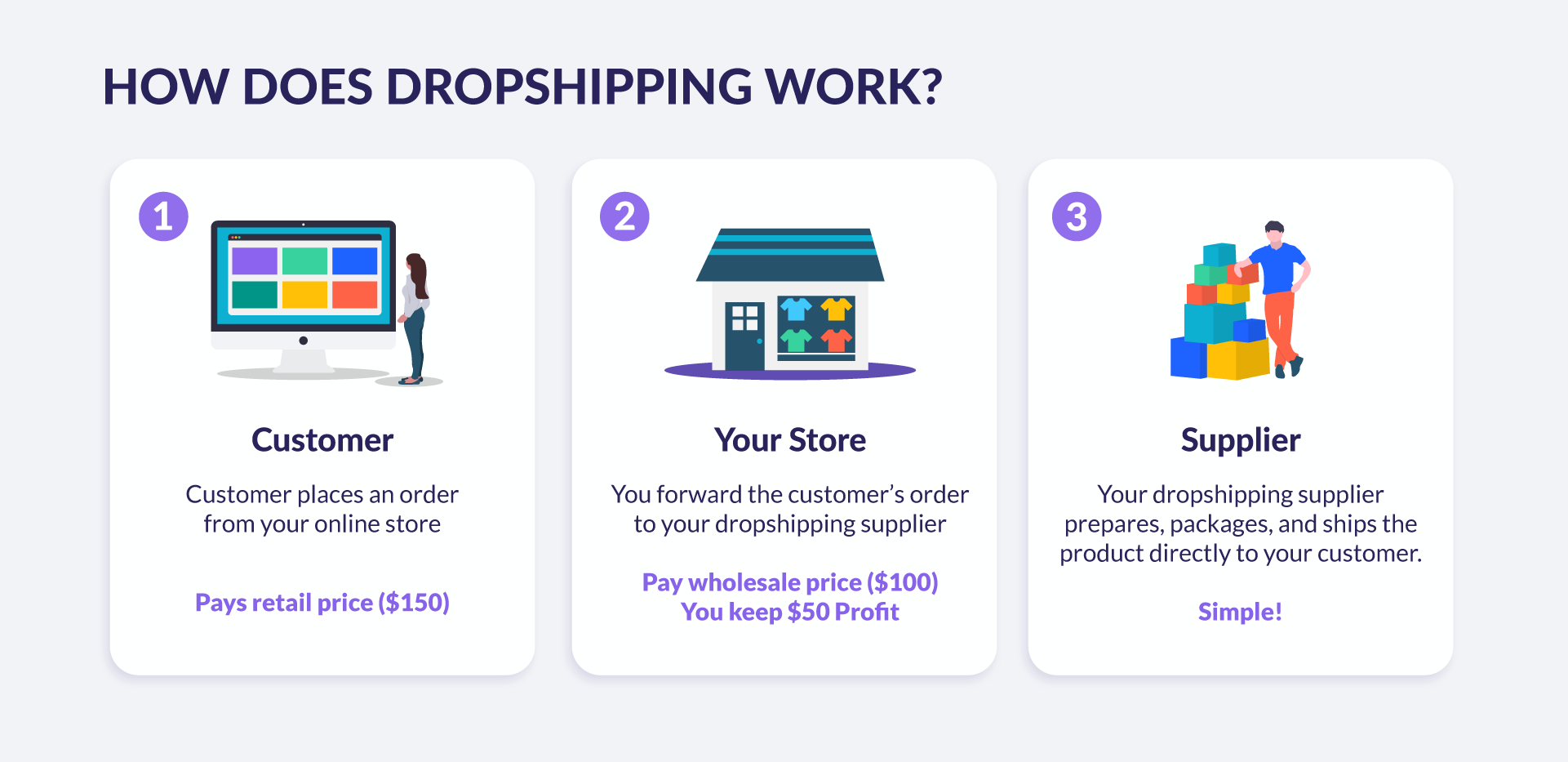
So, where does your profit come from?
Well, you charge the retail price for your products – as customers, most of the products we buy are charged at the retail price. For example, if you’re selling sunglasses, you might charge your customer $50 for one pair.
You then pay your supplier the wholesale price for the same product. Wholesale price is what retailers usually pay for products when purchasing from manufacturers, and it’s cheaper than the retail price. So, for that same pair of hypothetical sunglasses, you might pay your supplier $40.
That means you end up with $10 profit!
One of the main draws of dropshipping is that you don’t have to invest a huge pile of money buying up tons of stock in order to start selling.
This makes it a much more affordable and manageable business model. You don’t need large sums of cash to get started, and you don’t need to worry about hiring a warehouse to store stock – or trying to fit 100 boxes of sunglasses into the spare room!
Dropshipping Statistics
- The value of the global dropshipping market is expected to reach $243.4 billion in 2023
- The global dropshipping market value is on track to reach $476.1 billion by 2026
- Roughly 33% of online stores use a dropshipping supplier to fulfil orders
Find out more
- Does starting a business without storing or shipping inventory appeal to you? If so, check out our full guide on How to Start an Online Store Without Inventory for more helpful tips
- Still confused? Our Dropshipping vs Ecommerce Fulfillment breakdown explains the difference!
How To Start a Dropshipping Business
Psst! Not quite feeling ready to read a whole guide on dropshipping? We hear you. That’s why we created this handy infographic to walk you through the key steps of how to start a dropshipping business. It’s the short, sweet, and simple version of our full guide, to save you time and effort.
Take a look at the steps below for the quick summary of our guide, and then feel free to dip in and out of the article as and when you need to. Enjoy!
1. Find Your Niche and Products
- Useful tools include: Google Trends, Kickstarter, and Trend Hunter
2. Pick a Sales Channel
- Choose between an online store or online marketplace
- Popular options include: Wix, Shopify, BigCommerce, and Amazon
3. Choose a Supplier
- Order samples
- Watch out for fakes
- Ask questions
4. Sort Out the Legal Side
- Apply for an EIN
- Watch out for fakes
- Ask questions
5. Start Marketing
- Dedicated 75% of your time to marketing in the months following your business launch
#1. Find Your Niche and Products
Finding a niche is helpful for connecting with a target audience, and for sourcing relevant products. Niches are important, but products are even more vital for the success of your dropshipping business. Do market research, find ways to add value, and think about what sorts of customers you want to attract to your store. This is the first step, and arguably the most important – so don’t skip it!
It seems that most guides about starting anything begin with “Find your niche…” – and dropshipping is no different.
Finding your niche is important because it helps you narrow down your target audience, and the types of products you’ll be focusing on. It can even have a considerable impact on the success of your dropshipping business in the long run.
There are various ways to approach niches – you can either jump on hot trends or choose more long-term, steady options. Bet you can guess which one we most recommend!
Hot trends are fine for short-term wins, but they’re super competitive, can come with rock-bottom prices, and don’t last very long. You’re better off choosing a niche that consistently delivers, and gives you repeat customers.
Lewis Smith also advises new dropshippers not to focus too much on quick wins:
“Beginners should be focusing on choosing a long-term niche market with consistent demand and supplier availability, at a high enough price point, with competitive 1-2 day delivery times.”
So how do you go about picking a profitable niche?
Well, it’s always a good idea to carry out some research – and there are plenty of tools out there to help you get started. Here are our top picks:
- Google Trends – this handy tool shows you how popular certain search terms are over time. You can even view search interest by region, and compare it to other search terms over time. Oh, and it’s free!
- SEMrush – even if you don’t use this for narrowing down your niche, this is a great all-rounder to help you stay on top of your marketing. From keyword research to its market explorer, SEMrush is a powerful asset for any business.
- Google Keyword Planner – this popular tool helps you decide which keywords you should target, see how often certain keywords are searched, and discover new relevant keywords to explore.
- Kickstarter – it’s free, it’s easy, and it’s another great way of finding trending products. You can search by category and region, and it shows you which products are taking off – making it a more specific step up from Google Trends.
- Trend Hunter – a huge online community dedicated to sharing market trends. It’s the world’s largest trend community, and with 20 million monthly views, you’re sure to be in good company – and find some shiny new ideas for your business!
You might already have an idea of what you’re looking for, but if you don’t, then it can be hard to find direction amongst all those trends.
If you’re struggling to get started, we recommend trying to find a niche that combines profitability with your passion. That way, you won’t end up bankrupt, or bored out of your mind selling products you have zero interest in!
To find a niche you’re passionate about, ask yourself:
- What products do you buy the most?
- Which websites, blogs, and stores do you visit most often?
- Are there any social media pages you particularly enjoy?
- Do you collect any products? Anything you buy over and over?
Make sure you combine passion with research, though – once you’ve narrowed down your niche, check that it’s profitable using the tools listed above.
To help, we’ve done some digging and found some of the most profitable niches that are set to keep growing.
We looked at the most profitable ecommerce markets, such as fashion, electronics and media, and furniture – as shown by Statista. Within these markets, there are categories such as footwear, books, and household appliances. It’s within these categories that you’ll find niche products to sell.
Below you can see a breakdown of each market, and their expected growth between now and 2024:
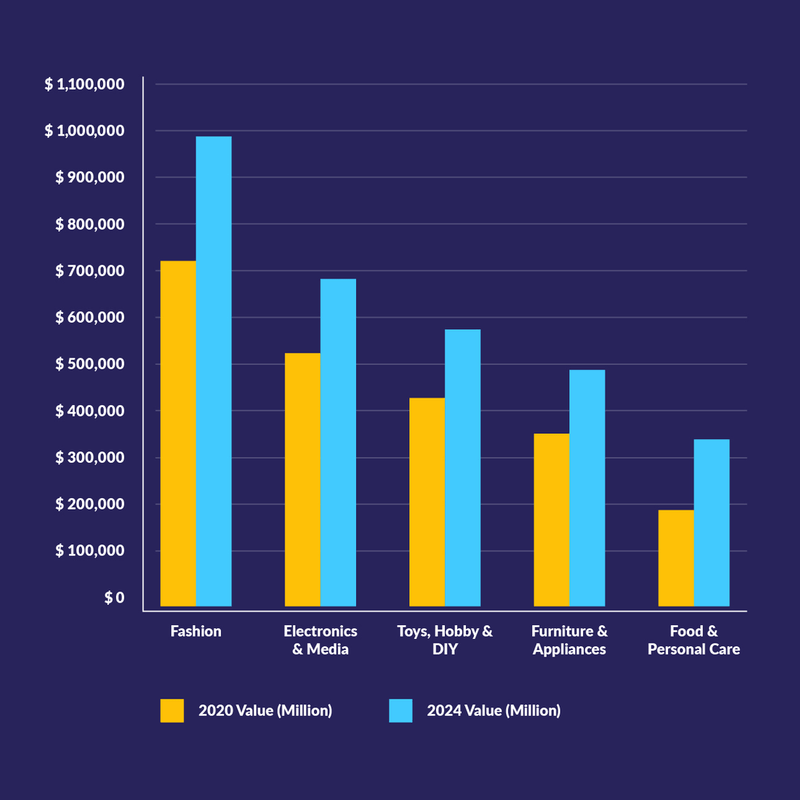
According to Statista, fashion is the highest value ecommerce market, and it’s set to grow to over $900 billion by 2024, making fashion a pretty profitable market!
But which categories should you be finding products in? We analyzed the data and found the top three categories that are set to grow the most ahead of 2024:
- Bags and Accessories: expected to reach over $200 billion
- Household Appliances: expected to reach over $190 billion
- Apparel: expected to reach over $640 billion
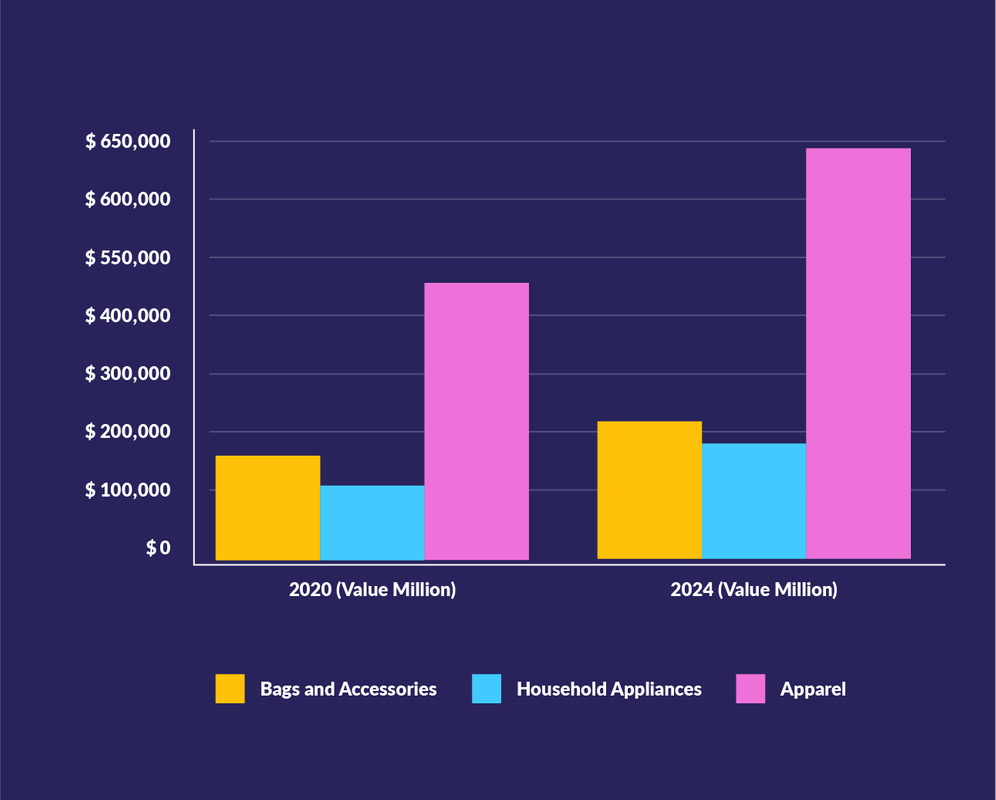
Other promising categories include Toys and Baby, Food and Beverages, and Hobby and Stationery – which includes things such as books and selling online novelties. On the other hand, the category with the lowest predicted growth is Footwear.
FROM THE EXPERTS
Try to choose products that people buy repeatedly. When someone buys a canvas, he or she probably won't need another one for a very long time, if ever. T-shirts, however, are often re-purchased on a regular basis.
Dropshipping app Oberlo also carried out research into the most popular niche categories. It identified the 10 best categories, and drilled down into the highest-performing niches for each one.
For example, it showed that women’s clothing and accessories was the top dropshipping category – and that within this category, the niche that received the most amount of orders was lingerie.
The Oberlo report is definitely worth checking out to help you narrow down your niche even further!
Once you’ve found your niche, you can start sourcing products. Ricky Hayes, a successful seven-figure dropshipper, had some wise words about picking your products:
FROM THE EXPERTS
Honestly, the key to standing out from others is having something new to the market that is going to blow them away. From all the stores I own, the people I mentor and clients I’ve helped, I see a common thread – the products that generally do best in the short, medium, and long term are ones that are: 1. Solving problems 2. Unique 3.High quality. These are the traits I look for when I promote a product because people buy more on a need than a want in most instances. When you look at a product, picture the audience – picture their gender, picture their age, picture them using the item, and picture if it has mass appeal…
Here are some top tips for finding the perfect products for your dropshipping business:
- Identify any current trends. Are there any hot products in your niche? Combining trending items with more steady ones is a good way of boosting sales.
- Carry out product research. Resources like Google Trends and Kickstarter.com are helpful for seeing what people are interested in.
- Find ways to add value. Can you increase your product’s worth yourself? Adding value can help you beat the competition – this could be through a unique guide to using or installing the product, for example.
- Think about your audience. Will your product appeal to hobbyists? Or businesses? Ideally, you want to sell a product that people will come back for again and again, and that they can’t get their hands on easily in their local store.
- Don’t be afraid to stretch your niche… sometimes. We know we just spent ages helping you find your perfect niche, but hear us out. If you’re selling camping equipment, do you have to stick solely to camping stoves and tents? No! You could experiment with related items, such as beach towels, hiking boots, or cozy blankets. Start off small and see how your customers react.
It’s worth dedicating time to finding the right products, as this will affect everything from your audience to your supplier and beyond. We suggest starting with a niche mostly because it can make it easier to narrow down your products and make sure you don’t end up with a random selection of items in your store. You can also get inspired with our article on dropshipping business ideas.
FROM THE EXPERTS
I think that one of the reasons my dropshipping stores do well is that I focus on one product at a time. It forces me to really get to know the audience and learn what resonates with them. That way there’s a much higher chance that the product will perform well when tested. A lot of beginners seem to get shiny object syndrome - always jumping from product to product and never really spending enough time on any of them. A split focus like that never produces good results for me.
If you want to sell your own products instead of sourcing someone else’s, you might want to check out print on demand dropshipping as an alternative option.
Raitis Purins, Head of Marketing at Printful, says:
“The most popular product for print on demand today is also the most simple one – a black t-shirt. However, variety is always appreciated – we see that embroidery products like hats are getting attention. On top of that, we recommend exploring home and living products (canvas and mugs are very competitive) and athletic products (with the growth of athleisure culture, there’s a progressing demand for these items).”
- Found your niche
- Carried out product research
- Picked your products
#2. Pick Your Sales Channel
Next step: it’s best to evaluate the various sales channels available. If you settle on a sales channel first, you can then make sure your dropshipping supplier perfectly suits your chosen platform. Examples of sales channels include building your own online store, with platforms like Wix and Shopify, or using a marketplace like Amazon or eBay. We’ll look at the main players, and help you find the perfect one for your dropshipping business.
So, you’ve chosen your niche and selected your products. Now it’s time to find a channel for selling! By choosing your ecommerce platform first, you can then find a dropshipping supplier that best suits your needs.
For example, if you build an online store with Shopify, DSers is the perfect supplier.
Sales channels are simply where you sell your products, and how you get them in front of customers. Selling face-to-face is one example of a sales channel, but there are plenty of options. The best ones for dropshipping are:
- Building your own online store using an ecommerce builder (like Wix, Shopify, or BigCommerce)
- Selling through an online marketplace (like Amazon or eBay)
Online Store vs Marketplace
This is a common quandary in ecommerce – build your own, or make the most of a ready-made platform? Each side comes with its own pros and cons, so it’s worth weighing up your options before choosing.
Ecommerce builders like Wix and Shopify give you the tools to easily create your own online store. You have to grow your own traffic and invest some time, but the upside is that you have total control over your store’s design. Branding, marketing, and stock inventory are also much easier to manage through an ecommerce builder.
Online marketplaces are popular because they have tons of traffic already for you to tap into. If you list your products on a site like Amazon, for example, you have a good chance of being seen by tons of potential customers.
The downside? You have no control over branding, you’re at the mercy of their policies, and you often have to pay selling or listing fees.
On the whole, we recommend building your own online store – it’s better for supporting long-term, successful businesses rather than hobby selling. But why not take a closer look at each option before deciding?
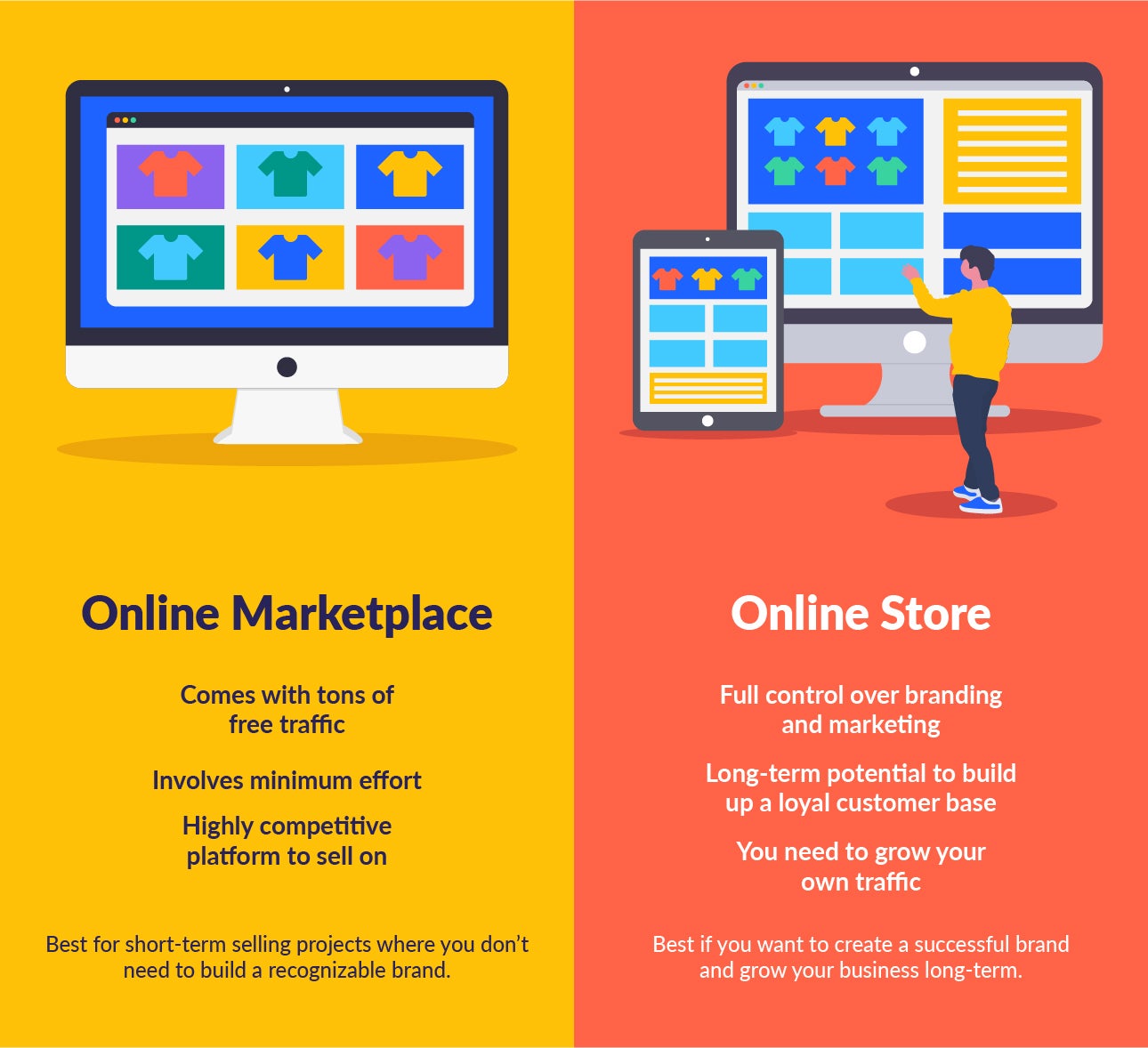
Building an Online Store
Using an ecommerce website builder is a great option for tech beginners who want to build an online store quickly. Let’s take a look at these three platforms in more detail:
| Wix | Shopify | BigCommerce |
| Starting Price | Starting Price $29 | Starting Price $29 |
| Pros
| Pros
| Pros
|
| Cons
| Cons
| Cons
|
| Visit Wix | Visit Shopify | View BigCommerce |
Wix
When we carried out research to discover the best ecommerce builders on the market, Wix hit the top of our list with a score of 4.7 out of 5 in our ecommerce research!
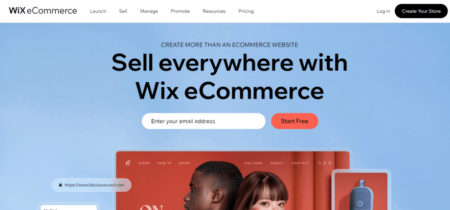
Wix quite literally does it all. Its ecommerce features have improved in recent years, especially its dropshipping capabilities, enabling you to source from over 800,000 ready-to-sell products.
Wix connects you with quality third-person apps such as Modalyst, Spocket, and 365Dropship. Wix also gives you absolute creative control over your store and products – more than Shopify or BigCommerce. It’s a complete package, perfect for beginners and those making a small online store.
FROM THE EXPERTS
In comparison to many other ecommerce platforms, Wix's app store contains significantly fewer dropshipping applications. However, the Modalyst, Spocket, and Printful drop shipping applications that can be found on that website are quite nice. I particularly enjoyed the feel of Modalyst and how effective it was at locating products and suppliers. Modalyst made it simple for me to add dropshipped products to my Wix store and modify their pricing and other details. Spocket, on the other hand, can be particularly useful for individuals who wish to dropship products from the United States or Europe and so give reasonable shipping times to customers in those locations. And finally, Printful can be an excellent option for individuals seeking a simple dropshipping solution. Additionally, Printful is free, which is obviously very wonderful.
Shopify
Shopify earns some serious dropshipping kudos thanks to its top-rated dropshipping app DSers, scoring 4.6 out of 5 in our recent ecommerce web builder research.
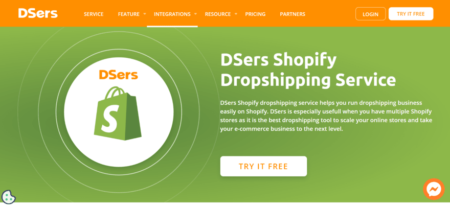
DSers can easily integrate with your Shopify store. Simply explore the available AliExpress products and import them to your store to get selling. DSers lets you automate tasks and there’s an inbuilt Supplier Optimizer feature to help you find the best-rated products.
In fact, DSers has helped dropshippers manage over 150 million orders!
You don’t have to use DSers, of course – you’ll find tons of other apps in the Shopify App Store too, including Printful, and Spocket.
FROM THE EXPERTS
I prefer Shopify because it is the quickest and easiest, and the industry leader in the ecommerce space. The biggest benefit of this is you have a huge community of people to help support and nurture you if you need help (which you will), so you can build your skills and create the business of your dreams. It also allows for the best customization, so keep that in mind. Personally, I recommend for those starting their dropshipping business to build a basic website on Shopify as best you can (without worrying about every detail), and get traffic running there. This will be where you learn the most, because you can always improve your site easily over time.
BigCommerce
BigCommerce is known for its ability to support online stores through rapid growth with its set of in-house features and high quality app integrations. This is why it scores an impressive 4.2 out of 5 in our ecommerce builder research.
You can choose from a range of apps to suit your business the best. Printful and AliExpress are just two of the most popular among the choices available.
One of BigCommerce’s greatest strengths is its multichannel integrations. That means combining your store with other sales channels to maximize your traffic and sales – so you could sell through your store and Amazon. Best of both worlds!
BigCommerce stands up pretty well next to Shopify, too – it’s just not quite as easy to use because it comes with so many powerful features. But BigCommerce is still a great choice, especially if you have big (get it?) plans for your dropshipping business.
Use an Online Marketplace
Unlike building your own online store, using an online marketplace allows you to tap into an already existing base of customers i.e. Amazon and eBay users. All you have to do is list your products on the marketplace website, and you can start selling.
However, unlike building your own online store, you’ll be competing with thousands of other merchants on the same website which can make it hard for your brand to stick out.
Amazon
You’ve probably heard of Amazon, given that it has over 310 million users worldwide!
The obvious appeal of dropshipping through Amazon is that it has tons of free traffic just ready and waiting for you to sell to. You don’t need to worry about SEO, marketing, branding, or running ad campaigns.
People are on Amazon already – 61% of product searches in the US start on Amazon – so your products are in a great position to be found…
…or are they?
There are millions of products sold on Amazon, which means there’s a lot of competition, even when you break it down to your particular niche. And what can you do to really stand out? Well, not much – you have no real control over design or branding, color schemes, or rankings on Amazon.
Another drawback is that Amazon actually sells its own products, too – and you can bet that those items will appear above anyone else’s!
So, while it may seem easier on the surface, at the end of the day you’re likely to become obsessed with customer reviews and algorithm updates as much as you would be running your own store.
There’s no denying Amazon has major perks. It’s quick to set up, easy to sell with, and those traffic levels are hard to resist. However, it also charges you selling fees at 10% per product, plus a $39.99 per month subscription in order to sell through its platform.
One final thing worth mentioning is that Amazon has its own fulfilment service, called FBA (Fulfilment by Amazon). This comes with its own fees and terms, but basically means that you can dropship your own products – pretty neat!
| Amazon Pros | Amazon Cons |
|---|---|
| Huge levels of free traffic | No real control over branding, sales strategy, or rankings |
| Has its own fulfilment service you can use to store, package, and deliver your own products | No long-term customer connection – best for short term sales |
| It’s quick and easy to sell through | You have to pay listing/selling fees that can eat into your profits |
eBay
Another heavy-hitter in the online marketplace game, eBay has accumulated over 135 million users, making it one of the biggest marketplaces around. Similarly to Amazon, dropshipping on eBay allows you to start selling quickly to a large audience, and you don’t need to worry too much about branding or running marketing campaigns.
The main drawback, like selling on any online marketplace, is that you’ll be directly competing with thousands of other sellers. In fact, as of 2022, there are over 1.7 billion listings on eBay, which could make it difficult for users to find your products.
You can trust a household name like eBay to deliver when it comes to starting a dropshipping company – it offers seller protection, and the ability to list up to 50 items for free every month, and you only pay when the item sells.
| eBay Pros | eBay Cons |
|---|---|
| High volume of traffic | Competition with 1.3 billion listings |
| List up to 50 items for free per month |
Does It Have To Be One or the Other?
No! You can choose to combine different sales channels, so don’t stress out if you can’t decide. If you go down this route, we recommend first building your online store and setting up your dropshipping business that way.
This is because it’ll make your business easier to manage in the long run. Ecommerce builders like Shopify and BigCommerce have impressive inventory systems built-in, making your life much easier. You can then expand out to sell on Amazon or eBay if you want to.
- Done some research on different sales channels
- Decided which sales channel best suits your business
More Information
- Shopify Review: Our review gives you a full look at Shopify’s strengths and weaknesses.
- BigCommerce Review: Discover BigCommerce’s pros and cons in our detailed guide.
- How to Dropship on Wix: If you already have an ecommerce website with Wix, check out our in-depth guide for dropshipping.
- How to Dropship on Squarespace: Did you know that you can also dropship on Squarespace? Find out more!
- Shopify vs Amazon: Find out which platform is better for you in our comparison.
- How to Start an Online Retail Business: Strike out on your own and explore our guide to help you get started in just nine simple steps!
#3. Do Competitive Research
Once you have your niche chosen and sales channel picked, it’s time to scout the competition. There are an estimated 24 million ecommerce sites out there, the majority of them using dropshipping, so it’s fair to expect some competition, even in a rarer niche. Learn as much as you can about what they do and add it to your own business plan.
You might think now’s the time to start contacting suppliers, but there’s one more crucial step we ought to mention: competitor research. If you jump into dropshipping blind, there’s a decent enough chance you may just get spat out the other side, as 9 out of 10 dropshipping companies fail within the first four months.
Learning from the competition is an easy way to give your business the best start. Your competitors have already made mistakes and learned from them to achieve their success, so there’s no reason you need to waste time and make them yourself! Things like prices, discounts, shipping options, products offered, and even down to font and color use: all will contribute to a store’s success, and you can learn and add all the best parts you like to the market research for your online business.
There are numerous ways to do competitor research, but to save time here are the three best:
#1. Google Searches
Google searches should obviously be your first port of call. This is where your audience will most likely find your site, so it’s important you scope it out and see who Google is recommending for your niche.
Google some of your most important keywords and take a look at who is in the top 10 on the results. This is who you will be competing against, so take a good look at how each promotes and sells that product. Once your store is live, keep checking the results page to see where you’re positioning. Once you crack the top 10, you’ll know you are succeeding. Who knows, you might even get the coveted number-one spot!
#2. Competitor Spy Tools Like Similarweb or Alexa
If you want a bit more of a comprehensive rundown of how your competitors are doing, online tools like these are great for getting detailed reports. They give you a list of competitor website information, such as their social media profiles, top traffic sources, number of visitors, and who their competitors are, meaning you can cross-reference with your own site and see oncoming trends.
#3. Browse Social Media
Many social media sites have made movements to add online marketplaces, such as Facebook and Instagram. These sites have become big for dropshipping as they attract many people’s eyes to begin with, allowing customers to see a product and buy it all without leaving the website they were on.
Look at how these businesses communicate with their customers, how their feed is designed, and how much engagement it gets—you can even follow its feed to never miss a beat. Use this information to find ways for your business to stand out and improve your social media marketing strategy.
#4. Choose a Supplier
Choosing the right dropshipping supplier is essential for the success of your dropshipping business. You can only be as good as your supplier – you’re relying on them to ship good quality products quickly to satisfy your customers. Below, we outline some top tips for finding a trustworthy dropshipping supplier for your business.
Once you’ve found your ideal products and sales channel, you need a supplier who can, well, supply them for you!
Your dropshipping business is pretty dependent on your supplier doing a good job. Your customers’ opinion of you rests on the shipment and quality of the product that arrives – none of which you have any control over.
You need a supplier you can trust!
As you’d expect, there are many suppliers out there. Some are good. Some are not so good. And some should be avoided at all costs. Here’s how to tell the difference…
- Order a sample product from any supplier you’re considering entering into a relationship with. Make note of the delivery time and product quality in particular.
- Watch out for fraudulent dropshipping suppliers – they’re out there! People sometimes try to act as a middleman between you and the real supplier so that they get a cut of your profits.
- Do some digging. Most wholesalers don’t put much effort into their marketing or SEO – try different search terms, and don’t be put off if your supplier’s website looks dated.
These tactics should help you separate the good quality suppliers from the bad – and remember to look out for the frauds!
Click the plus icon below to discover three top ways to avoid such dishonest dealings, or carry on reading to learn five great methods for finding your perfect dropshipping supplier.
1. If they ask you for an ongoing fee or service charge, take a step back. Most genuine wholesalers will simply make money when you buy their products, not charge you a monthly fee.
2. If they offer “wholesale” prices to anyone and everyone, they’re likely a retailer overcharging its customers. You should have to meet certain criteria and get approved before any real wholesaler will accept your order – it’s not available to the wider public.
3. If they make grand claims about promising you high margins, be wary! Dropshipping by its very nature comes with low profit margins – any supplier offering a ‘get rich quick’ type scheme is probably trying to lure you in. Don’t fall for it!
5 Methods for Finding a Dropshipping Supplier
There are various ways you can go about finding a dropshipping supplier. Here are the main approaches you can take…
1. Contact the manufacturer directly
This is one of the best ways to find trustworthy suppliers. First, get in touch with a product’s manufacturer and ask them for a list of their wholesale suppliers. Then contact these wholesalers and ask if they support dropshipping!
2. Use an ecommerce builder
Examples of ecommerce builders include Shopify and BigCommerce – you can build your own online store, and then add an app that lets you import products from dropshipping suppliers. This is a really easy way of getting started, which we’ll dive into in more detail later.
Here’s what Sebastian of DSers plugin:
“DSers is an amazing app that has definitely made my life so much easier. With it, I can easily find, synchronize and organize new products for my store and complete orders for my clients in a bulk. Without it, Shopify would be a much more consuming platform for vendors, but DSers makes it very easy.”
3. Order from the competition
This is a neat industry hack – it’s most helpful if you’re struggling to find a supplier, so don’t rely on it from day one.
Here’s how it works: you find a competitor who you suspect is also dropshipping, and place a small order with them. Upon receiving the product, get your detective hat on – find the return address and Google it. This should lead you to the original shipper… aka the dropshipping supplier.
4. Go to a trade show
If you like getting out there and meeting people face to face, you should consider going to a trade show. This gives you the chance to mingle with key players in your dropshipping niche.
You can make contacts, carry out product research, and scope out potential suppliers – all at one event! Just a heads up, though – you’ll need some time and money in order to attend. You can check out upcoming trade shows with a simple Google search – sites like SaleHoo and WholesaleCentral have trade show calendars to help you out.
5. Pay for a supplier directory
Supplier directories can be helpful when you’re first starting out – they‘re usually ordered by product or industry, making it easy to find relevant suppliers. They’re perfect for bouncing ideas around and are usually vetted to make sure the suppliers listed are genuine.
Directories can reduce hassle, save you time, and help generate new ideas. Still, you usually need to pay for them, and may not revisit them after finding your suppliers.
Find Out More
Still looking for inspiration? Check out our list of Dropshipping Clothing Suppliers for our shortlist of some of the best suppliers for clothing stores on the market.
Contacting Your Dropshipping Supplier
So, once you’ve found your perfect dropshipping supplier – or at least narrowed down your options – what do you do?
First off, if you’re looking to make serious inquiries and really get the ball rolling, then you’ll need to be legally set up and ready to meet the supplier’s official criteria. We’ll talk about this in the next section.
If, for now, you simply want to ask a few initial questions, then you don’t need to worry about this just yet.
Aside from that, here are some quick tips on how to approach potential suppliers:
- Be professional. In emails and on the phone, be aware of the language, tone, and information you’re using. Be confident and polite, be active in your approach, and don’t make unreasonable demands – it’ll go a long way in settimg up a good relationship!
- Pick up the phone. For many people, this is enough to bring on a cold sweat – if so, don’t worry! Suppliers get tons of calls every day, so they’re used to it even if you aren’t – and giving your supplier a call is the easiest way to get answers to your questions.
- Be prepared. If you have questions, try writing them down before reaching out. Make sure you’ve done some research on the supplier, your products, and the legal side of things. This will help your supplier take you seriously.
Now is the time to ask as many questions as you have. This will not only help you decide if your supplier is trustworthy and the right choice for you – it will also prove to your supplier that you’ve done your homework, and are taking your dropshipping business seriously.
Click the plus icon below to reveal some of the best questions to ask!
1. Do you offer a dedicated sales representative?
2. Is your tech up to scratch?
3. Can you take orders via email?
4. What is your estimated delivery time?
5. Do you have a robust tracking system in place?
6. Can I use your product photos?
Make sure you always order sample products from any supplier you’re considering for your dropshipping business. This will let you evaluate them from a customer’s perspective – look at their customer service, delivery times, packaging, and product quality.
- Researched dropshipping suppliers
- Checked your supplier is trustworthy
- Contacted your potential supplier
- Ordered sample products
- Asked your supplier questions
Shopify runs a free training course to help entrepreneurs start their own dropshipping business. If you want extra advice on top of this guide, it’s worth checking out!
#5. Sort Out All the Legal Stuff
You’re setting up a legitimate ecommerce business, so you need to tick all the legal boxes before you can start selling. Most dropshipping suppliers will need some kind of legal documentation before agreeing to work with you, so it’s worth getting right first time.
When you’re thinking about how to start a dropshipping business, you can get caught up in niches and products, suppliers, and selling strategies. It can be easy to forget about the legal side of things – least of all because it’s something most people don’t really want to think about. Or not for too long, anyway!
But, if you’re serious about making your dropshipping business a success, then you need to be sensible about this step. It doesn’t need to be boring or stressful – this is what makes your business a reality, rather than just a dream.
Ready to make it real? Let’s go!
1. Check Your Local Legal Requirements
Dropshipping is 100% legal – but the requirements vary from state to state, and country to country. Make sure you double and triple-check before getting started. You might have to get a business license, for example.
2. Choose a Business Structure
A what?
Your business structure shows which category your business sits in – it’s a legally recognized characterization. Examples include corporations and nonprofits. There are many out there, but here are three of the most common:
- Sole proprietorship – the most basic and simple business structure. It comes with minimal filing and tax headaches, which is a bonus. However, there’s no liability protection, which could put your own personal assets at risk – for this reason, we don’t recommend it too highly!
- Limited Liability Company (LLC) – this registers your business as separate from you (in legal terms). This means you get a better level of protection if, say, you were to get sued.
- C Corporation – this provides the highest level of liability protection, which comes with greater peace of mind… and a higher price tag. Most major corporations set up under this category.
We can’t tell you which business structure you should choose. But on the whole, LLC tends to suit more businesses than others.
3. Set Up a Separate Business Account
Don’t mix your business finances with your personal finances. (Just don’t).
4. Apply for an EIN
EIN stands for Employment Identification Number, and you can apply for one easily enough through the IRS website. All businesses need one of these, even if you don’t have any employees.
An EIN is needed to:
- Apply to work with most dropshipping suppliers
- Pay taxes
- Keep personal and business taxes and finances separate (see step #3 above)
5. Register Your Business and Domain Name
You don’t want someone else copying your awesome business name, do you? To avoid this, register your business name with the relevant authorities. You’ll find helpful tips and advice for this in the US Small Business Administration’s guide: Choose Your Business Name.
- Checked your local legal requirements
- Chosen your business structure
- Set up a separate business account
- Applied for an EIN
- Registered your business name
#6. Start Marketing Your Products
Once your store and products are live, you can’t just sit back and hope people stumble across them. The internet is a big place, so you need to give your products the attention they deserve. Marketing is key to growing traffic and driving sales.
You’ve come a long way from dreaming of starting your own business, and Googling “dropshipping for dummies” when your boss couldn’t see. Now, with your store live and your products ready, you wait in breathless anticipation for the first sale to ping on your phone.
Nothing.
Still nothing.
Before you hurl your phone in frustration or give up on dropshipping completely, let us show you three top marketing tactics to get more sales rolling in.
According to Shopify, you need to spend at least 75% of your time on marketing for at least four to six months after launching your site. Yep, you read that right – so roll up your sleeves and get ready to spin some marketing magic!
#1. SEO
Dropshippers are reliant on SEO just as much as other online sellers. SEO stands for ‘search engine optimization’, and is the art of getting your site found in Google’s search results. If you have an online store, you need to optimize it so that Google ranks it higher up its search pages.
Do this by using keywords, linking to other pages on your site, and making sure your site is user-friendly, loads fast, and mobile-friendly. Starting a blog on your site can also do wonders for SEO, because Google likes long-form, high quality content.
Online marketplaces have their own kind of SEO. If you’re on Amazon or eBay, you have less control over how well your products rank in their search results, but there are still things you can do.
One major thing is to pay attention to your customer reviews, as these seriously affect how well sites like Amazon rank your products.
#2. Social Media
Pick the right social media channel for your business – not all stores should be promoting on Instagram, for example, so assess carefully where your brand fits best. You should also think about who is buying your products, and where they’re most likely to visit.
Post relevant, regular content that’s not too sales-y in nature – remember that people go to social media to relax, so don’t bombard them with pushy promotions.

If you get it right, social media can be a huge source of traffic. 75% of internet shoppers use social media to research products, so it’s worth your time and effort.
You’ll hear a lot about paid advertising on sites like Twitter and Facebook. We recommend getting to grips with your social platform first, growing some traffic, and then using paid adverts to boost your existing traffic.
Ricky Hayes advises new dropshippers to be careful not to rely too much on paid ads:
“For beginners, please focus on education as your top priority. Please do not fall into the trap that Facebook ads is the only marketing platform, and learn about Google, Bing, and YouTube, which are areas of great opportunity.”
#3. Product Images and Descriptions
Using stock images of your products can be great – they’re often provided by your supplier, meaning they’re professional in quality. However, it can also result in other dropshippers having the exact same product photo as you!
This can cause problems when you appear side by side in search results (on Pinterest, for example). To avoid this, try taking your own product photos. Make sure they’re good quality, clear, well-lit, and not blurry. We have a guide on how to take product photos if you need some tips!
You can also get one over on your competitors by writing persuasive product descriptions that really sell the product. Connect with the customer, be descriptive and concise, and you should see great results.
Raitis Purins gave us his advice on how to successfully market products:
“To be successful in marketing products, you should give all you’ve got to product presentation and let the price tag be just the price tag. It’s important to create a story that justifies the price.”
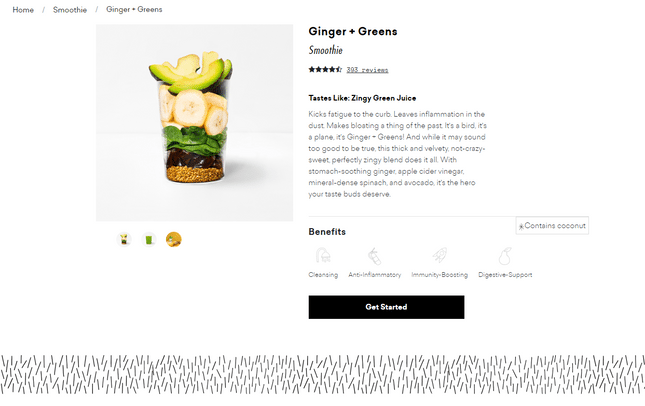
These tips are for getting started with your marketing. As always, there’s a lot more out there you can do, so don’t tick these off and then stop. Keep going, keep Googling, and keep learning.
Marketing is a never-ending job, so the more you enjoy it and embrace experimenting with new techniques, the more successful your dropshipping business should be!
- Picked your main marketing strategies
- Dedicated time to running your business’ marketing
- Started researching more marketing methods
#7. Analyze and Optimize
Nothing good lasts forever! If you want to maintain your audience and revenue, then it’s important to keep optimizing your store. This means keeping track and analyzing all of your store’s data and making minute changes here and there to keep it afloat.
Now that your store is up and running, you have to make sure it’s still firing on all cylinders! This requires looking at all the sales data, shopper behavior, and profit margins to make sure your store is still as optimized as possible.
You must record and analyze all the data your store is creating for your store’s future success. These will help you plan better strategies for the future and take your store to the next level over time.
The easiest way to get this data is through using Google Analytics or Google Search Console. Both online tools keep track of your audience metrics and give you insight on how well your site is performing, If you find your traffic decreasing, try and retool your marketing campaigns, or go back to and do some competitor research and see how the businesses are faring.
Should You Start a Dropshipping Business?
Dropshipping is a popular method of selling, but that doesn’t mean it’s for everyone. A lot of people start dropshipping for the wrong reasons, or with unrealistic expectations. So, should you start your own dropshipping business? Let’s find out…
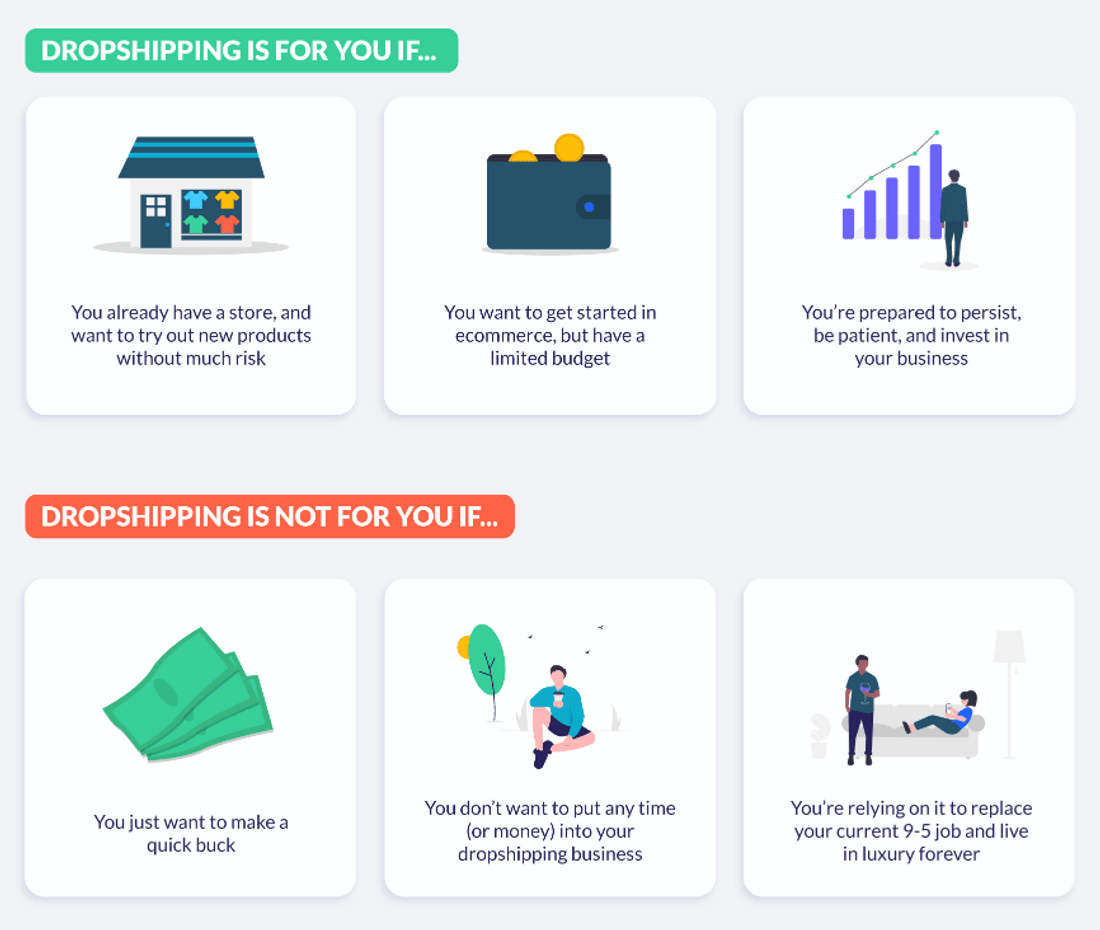
Okay, so you might be feeling a bit disappointed that dropshipping probably won’t make you a millionaire. (Only probably though – you never know!) But dropshipping is still a fantastic, and even lucrative business model to jump on.
We just want you to know these things before getting started so that you can focus on the really important and fun parts of dropshipping!
FROM THE EXPERTS
For beginners, I’d say that dropshipping is not a ‘get rich quick’ type of business. If you’re looking to build a long-term, sustainable brand that pays you a full-time income from just a laptop, for many years to come, then it will take time and dedication to set this up. However, this is a small price to pay to create a lifestyle of this kind. Anyone can throw together a basic e-commerce store and import a few products, but that’s how the people who came before us gave dropshipping a bad name.
You can read through some dropshipping myths below, or skip straight ahead to the pros and cons for a balanced look at what to expect from dropshipping…
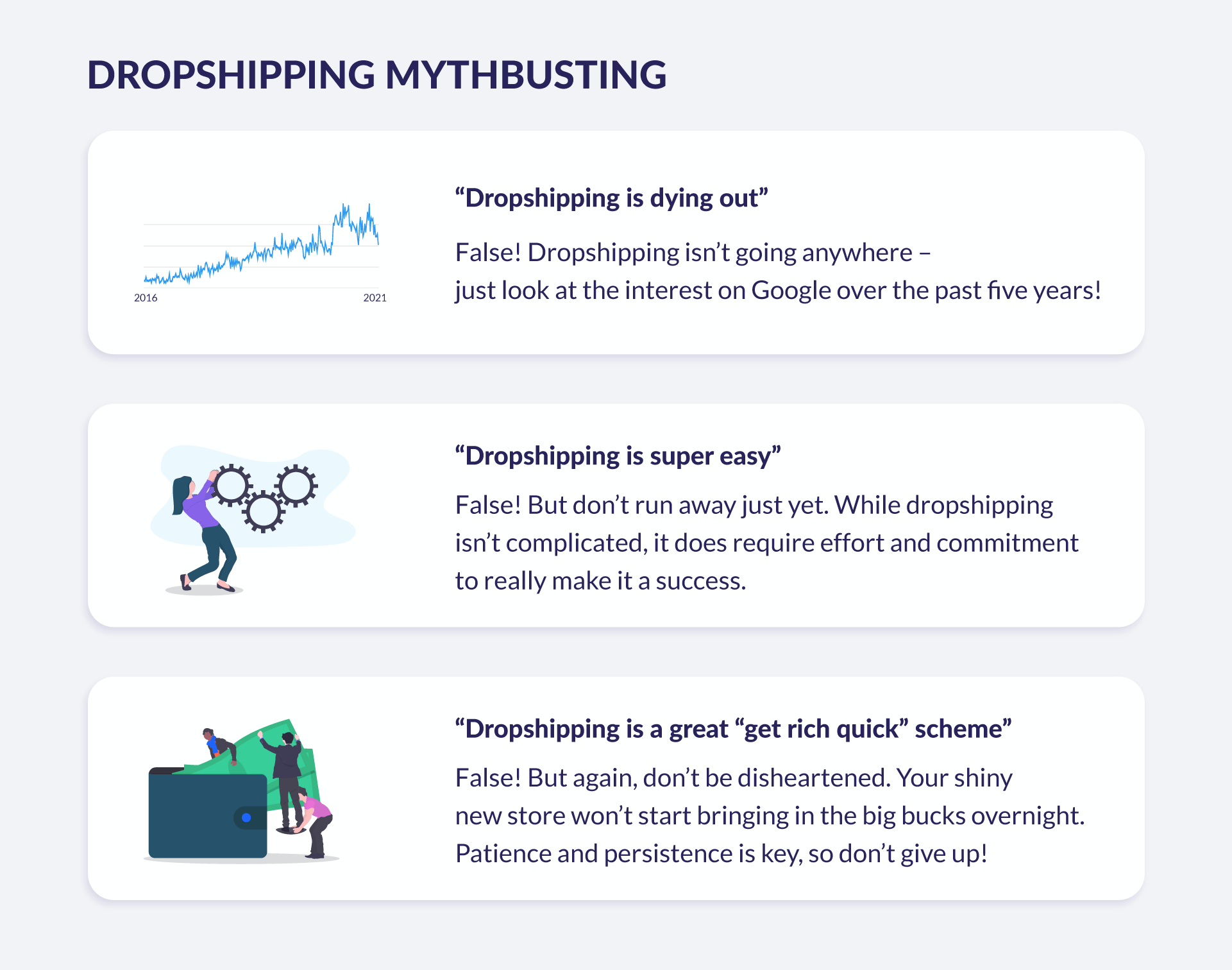
Pros and Cons of Dropshipping
Still unsure whether dropshipping is right for you? Take a look at the main pros and cons below, to see if it weighs up as a win for you!
| Pros | Cons |
|---|---|
| Don't need a big budget to get started – you can launch your ecommerce business without financial risk | It's competitive! Anyone can start a dropshipping business, meaning it feels like everyone does |
| Don't need tons of storage for the products you're selling | Low margins are the dark flip side to low overhead costs – you may feel pressured to sell cheaper to compete with other brands |
| It's flexible – you're not tied down to an office. Your business moves with you! | Shipping issues can crop up if you're working with multiple suppliers. Shipping needs to be fast and reliable (tricky when you're not in control), and it's you who has to handle any complaints |
FROM THE EXPERTS
You can run a dropshipping business from anywhere in the world as long as you have a laptop and an internet connection. You also don’t need any stock upfront which is perfect for someone just getting started in this. The biggest benefit though is once you have everything setup you earn money whilst you sleep. I still remember the first day I woke up and I had made more overnight than I was going to do by going to work for the entire week.
3 Common Dropshipping Mistakes to Avoid
You often hear a stat thrown around that 90% of dropshipping businesses fail. That’s a scary thought for new dropshippers, but if you look closer, it’s hard to find a reliable source for that figure.
What is true is that there are some common mistakes people make which can cause problems for their business, causing them to struggle. We’ve put together the worst ones so you can avoid making the same blunders.
#1. Not Investing Time or Money
This is one of the most common mistakes new dropshippers make – and one of the worst!
Dropshipping doesn’t need the same kind of lump investment that other business models do, but that doesn’t mean you shouldn’t put any money in. For example, setting up a Shopify store will cost you $29 per month, and you might have to pre-pay a supplier for products you haven’t sold yet.
These are normal costs to come across when running a dropshipping business, and if you’re reluctant to part with some cash, then you’ll quickly find yourself falling behind the competition.
However, the main investment dropshipping needs is time. That’s not to say it should up every one of your waking hours, but it still deserves your attention. Take the time to properly research products and suppliers, be attentive to your customers, and commit to your marketing. You’ll soon see the benefits!
It took Chris some real perseverance before he started making any serious cash:
“It took 5 failed store attempts before I finally started making any consistent sales, but when I did finally crack it, I made my first £10,000 within the first 6 weeks of my 6th store.”
#2. Neglecting Customer Support
This is another common mistake that can seriously damage your business. Just because you’re not shipping products to your customer directly doesn’t mean you can wash your hands of responsibility.
A whopping 80% of people stop doing business with a company because of a poor customer experience, so you can’t afford to not put the effort in!
Read product reviews, reply to both positive and negative comments, fix problems, and be an active presence for your customers. 93% of consumers are influenced by online reviews, so you can do yourself a favor by staying active in review sections and resolving issues as quickly – and politely – as possible. You can read our guide on how to respond to Google reviews if you need some tips.
If a customer is unhappy with their order, it’s you who has to step up and deal with it – even if the mistake wasn’t your fault!
#3. Focusing on the Wrong Parts of Paid Advertising
This is something Lewis Smith has seen all too often:
“A common mistake I see new dropshippers making is trying to drive cold traffic to their stores using Facebook and Instagram ads. When selling higher-value products, it’s much easier to serve the existing demand than it is to create new demand – that’s why the niche research and validation stage is so critical.
There are two ways to look at paid traffic:
The first is ‘Interruption-based marketing’, as you will no doubt have seen on your own Facebook and Instagram feeds (i.e. Those miracle teeth-whitening gels that seem to be everywhere).
However, at Dropship Unlocked we teach a more targeted approach to finding customers, known as ‘Search-Intent Marketing’. These are ads shown only to customers actively expressing an interest in buying your product (i.e: Google Shopping and Search Text Ads).
This focuses your advertising spend on only the most ‘ready-to-buy’ customers. We then run retargeting campaigns across social media channels to bring customers back to your site if they left without buying.”
Q&A With Dropshippers
Q&A With...
By far, the most rewarding part of my day is being able to spend it with my wife, because one of my primary motivations for creating a lifestyle business was spending more time with my family.
Then I hop on a Q&A call with members of the Dropship Unlocked (DSU) training program… It’s a really important part of my day, and a great way for DSU members to learn from each other, as well as myself.
That’s followed by a morning conference call with the ecommerce team that runs the day-to-day operations of my current dropshipping stores, including customer service, product uploads, and making sales…
By far, the most rewarding part of my day is being able to spend it with my wife, because one of my primary motivations for creating a lifestyle business was spending more time with my family. That’s why I love helping other people turn this into a reality, too.
My first mistake was that trend-led items have a short shelf-life, and without being able to compete with Amazon on delivery times, I was doomed to disappoint my customers. By the time the item had arrived in anyone’s homes, 20-30 days later, they’d already requested a refund for the delay or complained about poor quality.
…the lesson I learned was that by working with reputable UK-based suppliers (known as domestic dropshipping), selling higher-priced items (high-ticket dropshipping) could mean fast delivery and happy customers.
After much thought, I decided to shut down and start all over again with a simplified business model that allowed me to create truly valuable brands and stores that I was proud of.
Q&A With...
My biggest success was probably growing my business enough to give me the opportunity to pay off my mortgage. To say that my original goal was to earn £200 a month, being able to pay off my mortgage this quickly still blows my mind to this day.
My biggest struggles were probably just learning how to do everything myself. I’m a business owner, marketer, product researcher, customer service advisor, web designer, copywriter plus much more! I really need to start outsourcing but I’m very much hands on and I like to be in control of my business.
Q&A With...
When Printful had just started, there were little to no companies offering print-on-demand (POD) dropshipping services. By now we’ve already fulfilled over 15 million items, which shows the demand is increasing.
We are continuously investing in expanding the market to Europe, too. The Western European market grew by 150% in 2018 compared to the previous year.
Another market we’re starting to explore is Japan – we have launched a website in Japanese and we’re currently evaluating the market potential. Since the start of Japanese marketing campaigns, the number of Japanese-speaking customers has increased 73 times. It doesn’t correlate with revenue just yet, but this increase indicates good potential.
Q&A With...
It’s super important to take time to reflect on where you were a month ago. And keep looking back over your store and see if you can spot something to improve. Those incremental changes will compound and lead to building something successful.
I’d have to say my biggest struggle has been with the stock and inventory side of physical products. If you start dropshipping, you may go into it with the mindset of “Oh I don’t have to deal with inventory at all.” And while that may be true in the beginning, it’s easy to start running into issues as the sales grow.
AliExpress suppliers can be very vague about their stock levels, so you really have to stay on top of it and start ordering inventory once your cash flow can support it.
My first website looked terrible. But the fact that I can look back now and see that means I’ve progressed a ton.
It’s super important to take time to reflect on where you were a month ago. And keep looking back over your store and see if you can spot something to improve. Those incremental changes will compound and lead to building something successful.
Also, being part of a community really helps. Entrepreneurship can be pretty isolating if your friends and family don’t understand what you’re talking about.
Over the years I’ve spent a lot of time in Facebook groups asking questions and brainstorming. So now I’ve created my own to keep encouraging that. It’s called the Ecom Explorers!
Q&A With...
The industry is now moving towards building a brand, which basically is just getting a loyal customer who will buy from you, time and time again.
For at least six months I was mentally fatigued from overwork, because I was the sole provider of my income. This caused a great deal of stress, anxiety, and even depression at times. I only left my position when my business began to kick off – I could see consistency and longevity in my business, so I could ensure I wouldn’t go broke.
So in total, it took me a year and a half in my journey before I was where I wanted to be; where I was truly financially free, and able to take back control of my life.
Conclusion
You came to this article looking for answers on how to start a dropshipping business. Hopefully, you’re now confident enough to get started and turn those dropshipping dreams into a reality.
We’ve walked through the process, from picking your products all the way through to making your store – to which we’d recommended Shopify as the best for your dropshipping business. We realize it’s a lot to take on, so here’s a nice quick recap of those five steps:
How to Start a Dropshipping Business: 5 Simple Steps
- Find your niche and products
- Pick your sales channel
- Choose a supplier
- Sort out all the legal stuff
- Start marketing your products
Along the way, we’ve busted myths and tried to prepare you for what dropshipping is really like. With wise words from real-life dropshippers ringing in your ears, we hope you’re now excited to start your dropshipping journey! And don’t forget to take a look at all our useful dropshipping tips.






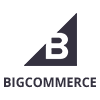
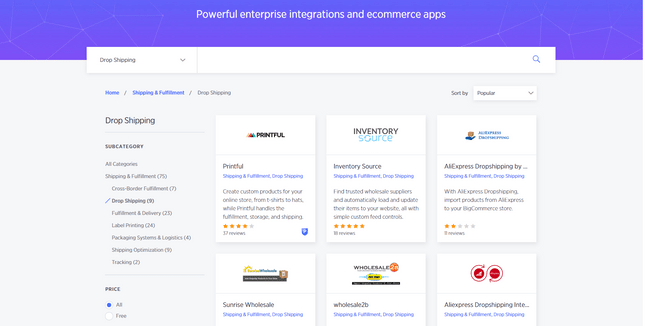
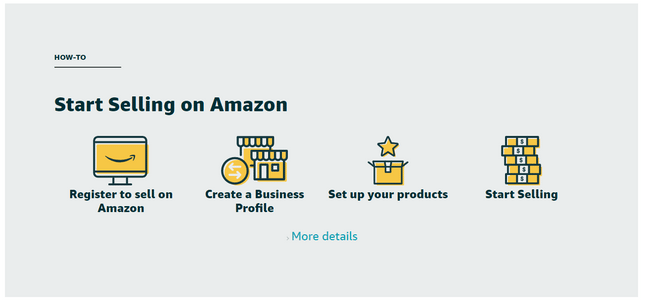
16 comments